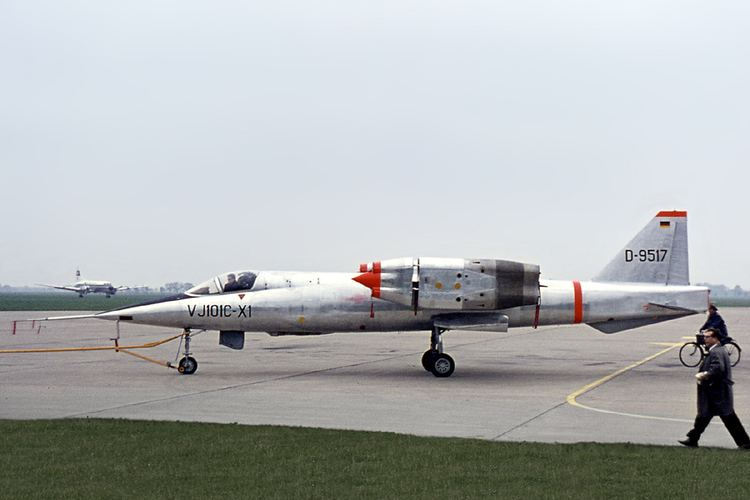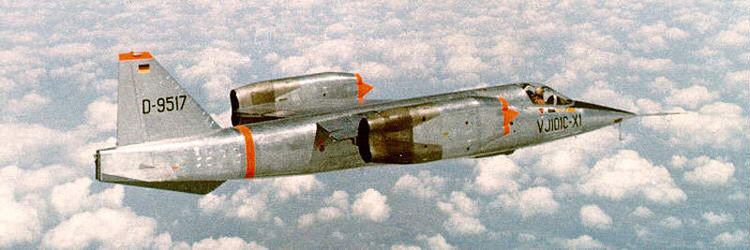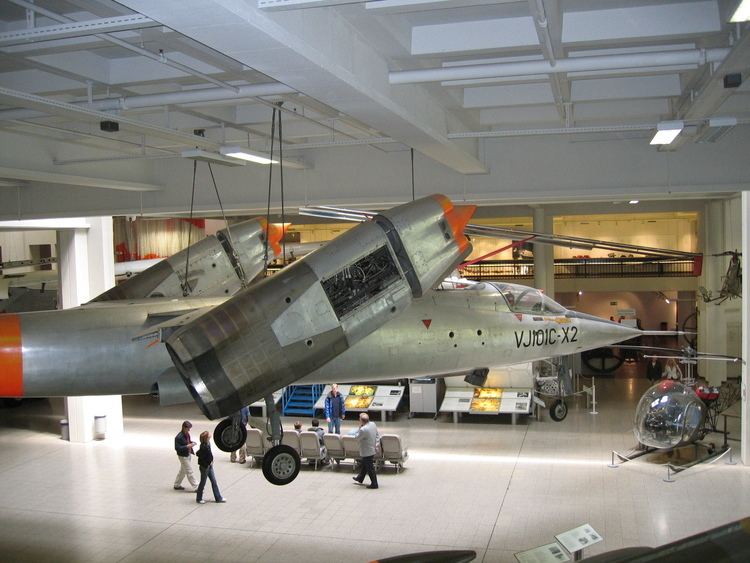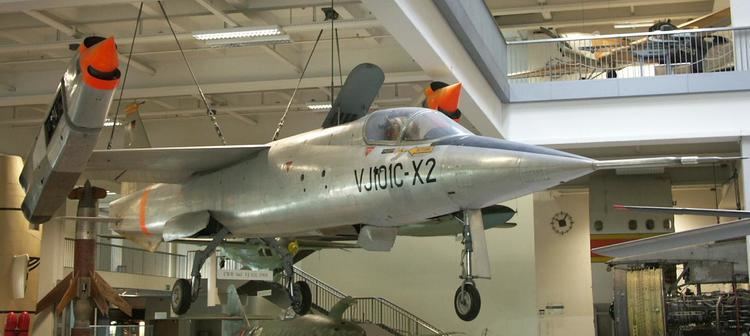Wingspan 6.6 m Retired 1968 First flight April 10, 1963 | Length 16 m Engine type Rolls-Royce RB145 Manufacturer Entwicklungsring Süd | |
 | ||
Ewr vj 101
The EWR VJ 101 was an experimental German jet fighter VTOL tiltjet aircraft. VJ stood for "Versuchsjäger", (German for "Experimental Fighter"). It was to be the basis for a successor to the F-104G Starfighter, but was cancelled in 1968 after a five-year test program, during which two prototype aircraft were built. The VJ 101 was one of the first V/STOL designs to have the potential for eventual Mach 2 flight.
Contents

Design and development

Heinkel and Messerschmitt had developed designs to meet the requirements of VTOL flight and by 1959, the two companies, along with Bölkow, had created a joint venture company called EWR, to build the VJ 101 D. The production VJ 101 D aircraft were to use the Rolls-Royce/MAN Turbo RB153 engine, a turbofan with thrust deflection. Two prototype aircraft, VJ 101 C, were to use the RB145 engine, a turbojet mounted in swivelling nacelles.

The new proposal merged the characteristics of earlier Bölkow, Heinkel and Messerschmitt designs into a sleek, streamlined platform. The VJ 101 C was similar in appearance to the Bell XF-109, both with paired engines in swivelling nacelles at the wingtips. In addition to the wingtip engines, two further lift jets were installed in the fuselage to supplement the main engines in hovering flight.

In order to test the concept, EWR built a test rig called the Wippe (seesaw) in early 1960. The simple device incorporated a rudimentary cockpit on a horizontal beam with a "lift" engine mounted vertically at the centre for preliminary single-axis tests of the control system. A later "hover rig" was built that had the skeletal fuselage of the VJ 101C with three Rolls-Royce RB108 engines installed in the approximate positions they would occupy in the final flying version. The small engines each had 9.3 kN (2,100 lbf) thrust, enough to lift the test rig. After initial testing in May 1961 from a telescopic column, the new rig was able to "fly" in free flight in March 1962. Additional tests with a cloth "skin" simulating fuselage and wings proved to be successful (showing satisfactory control in all seasons and weather conditions).
Testing and evaluation

Two prototypes were built: X-1 and X-2. X-1 was to have six RB145 engines: two mounted vertically in the fuselage for lift and four in the swivelling nacelles, all of 2,750 lbf thrust. X-2 was to have the swivelling engines reheated for a wet thrust of 3,840 lbf each, giving a design speed of Mach 1.8. Although the nacelle engines produced adequate thrust to hover on dry thrust alone, concerns over the smoothness of transition from dry thrust to reheat required the ability to take off vertically under reheat. This required a very short reheat pipe, to provide ground clearance. The reheated engines had a simple two-position nozzle, reheat and non-reheat, and the inlet duct could also be moved forward at slow speed or in the hover, opening an auxiliary air intake.

On 10 April 1963, the X-1 made its first hovering flight. The first transition from hovering flight to horizontal flight took place on 20 September 1963. The X-1 was first publicly exhibited at the May 1964 Hannover Air Show. The VJ 101C X-1 flew 40 aerodynamic flights, 24 hover flights and 14 full transitions. During these tests the sound barrier was broken, for the first time by a vertical take-off aircraft, but on 14 September 1964 a defect in the autopilot caused a crash. On July 29, 1964 the VJ 101 C flew at Mach 1.04 without use of an afterburner.
The second prototype X-2 with a new autopilot made a successful transition on 22 October 1965. The tests were subsequently continued with X-2, which in contrast to X-1 had afterburners. However the project was cancelled in 1968. The proposed VJ 101 D Mach 2 interceptor was never built. VJ 101 C X-2 hangs today in the Deutsches Museum in Munich.
Although the VJ 101C did not proceed to production status, other projects including the Mirage IIIV, Hawker P.1154 (a supersonic parallel to what would become the Hawker Siddeley Harrier) and the much later F-35 Lightning II showed the promise of VTOL fighters.
Operators
Specifications (VJ 101C X-1)
Data from Macdonald Aircraft Handbook
General characteristics
Performance
